

So you've just got yourself a shiny new Grainfather, and whether you're completely new to all-grain brewing or you've been 3V brewing for years, your first brew can be a little confusing, bewildering or unclear. So if like me you work better visually, I've put together a simple walkthrough with lots of pictures to guide you through your first brew step-by-step.
This is a long one so apologies for that, but hopefully it's mostly foolproof and comprehensive.
With the GF Connect, you can upload your recipe with temperature steps and timings and so on direct to the controller, but for this walkthrough we'll just do it manually to get you used to the basics.
Before you start, make sure to give the GF a thorough clean to remove anything left behind from the manufacturing process. The easiest way to do this is to follow the instructions on the side of the GF cleaner which you should have gotten with it. If not, simply fill with water, heat to 60°, add a few scoops of oxy cleaner, circulate through the chiller for 15 mins then through the recirc pipe for 15 mins. If you're not sure how to do this read on…
After cleaning you'll obviously need a recipe and all the ingredients, a vessel in which to heat the sparge water, be it a GF sparge heater, an electric boiler or a stock pot, a thermometer, plus a large mash paddle or spoon, preferably stainless steel.
When you're ready to begin, remove the grain pipe, plates and recirculation arm from the GF and set them aside for now.
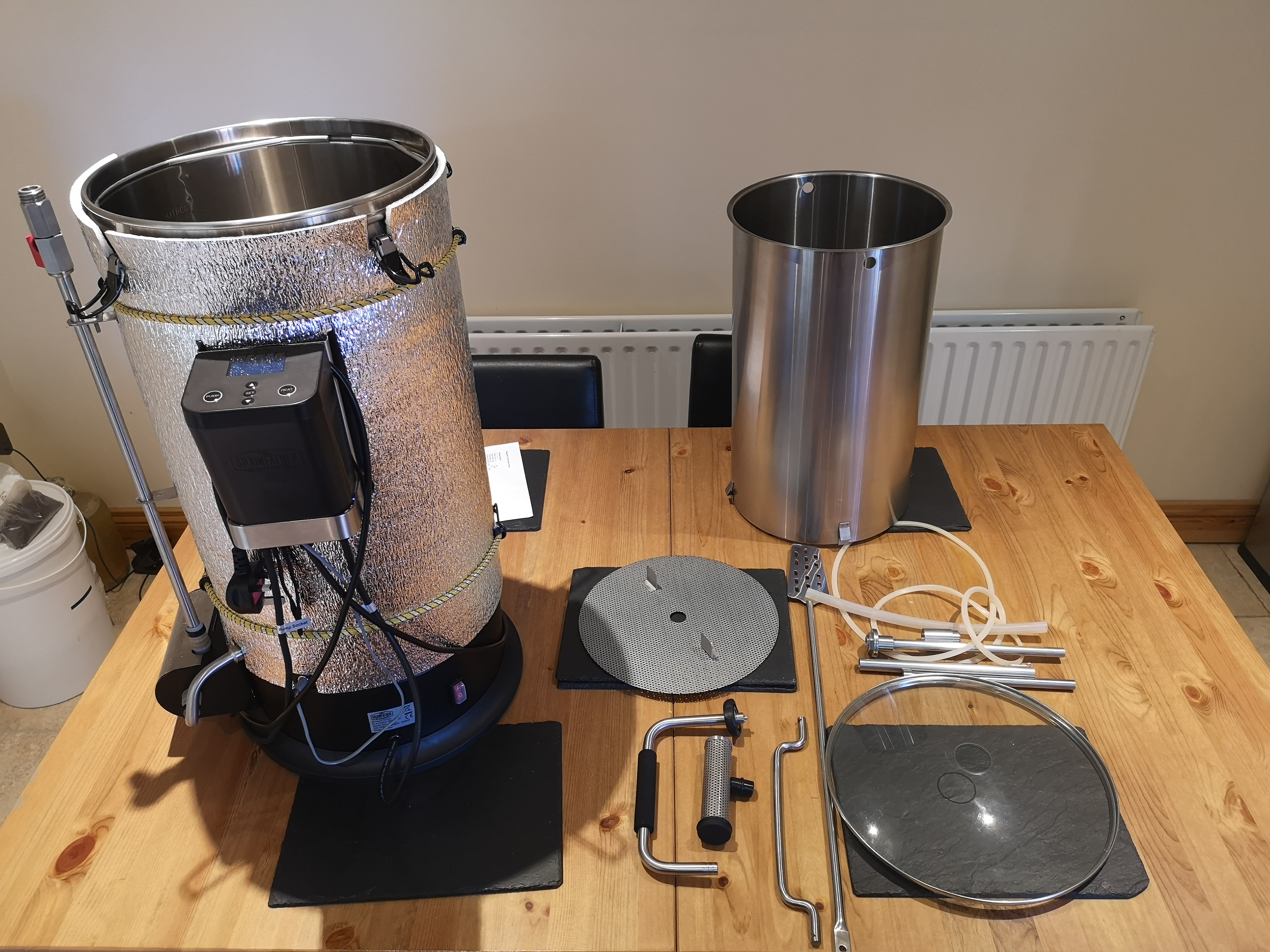
One little tip I was given, is to rotate the filter by 180° so that the rubber end cap is wedged against the temperature probe like the pic below. This makes it less likely to be knocked off during the boil.
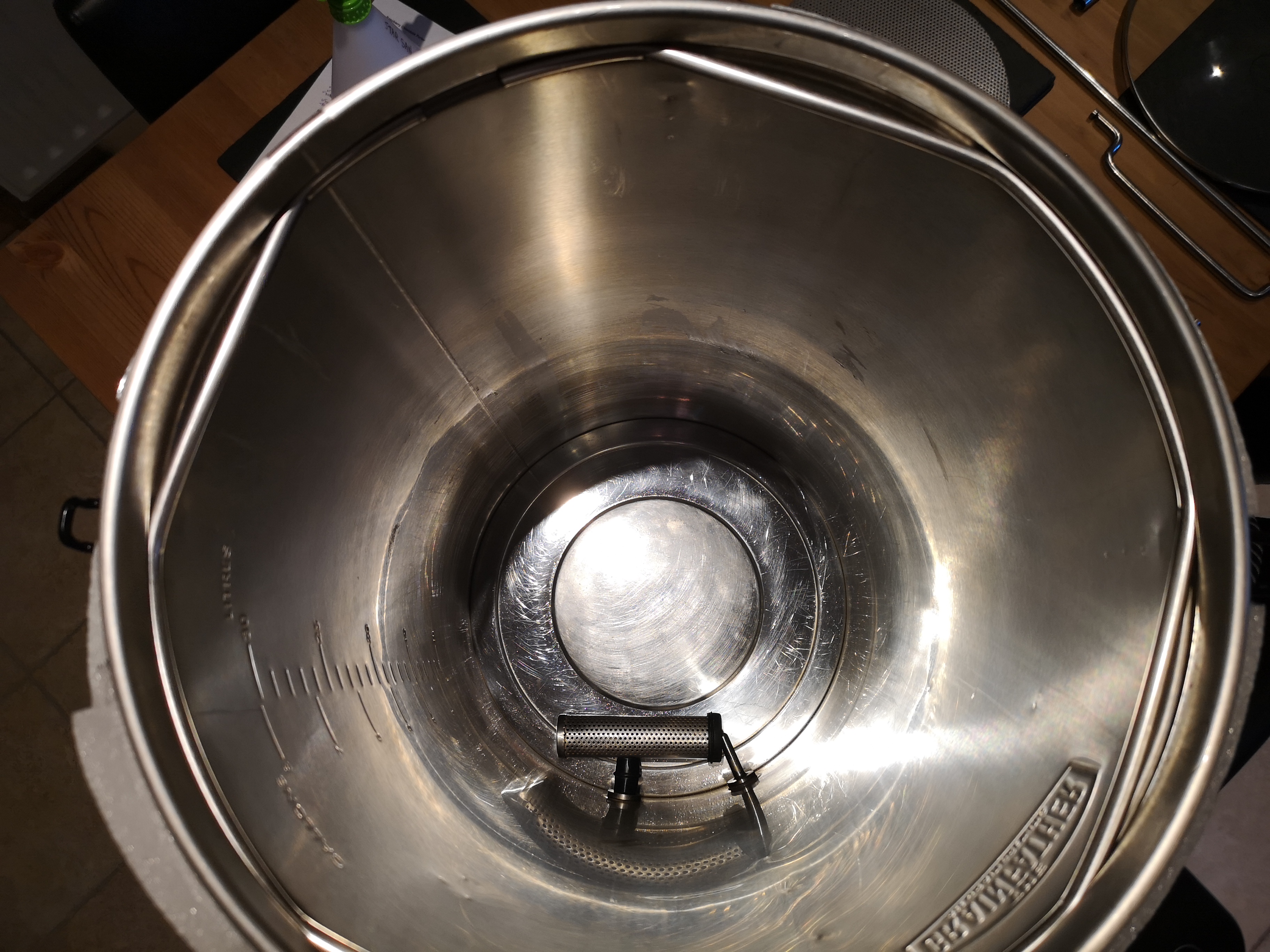
If you do this, the little rubber outlet tube should be rotated back to its original position so that the hole inside the filter is facing downwards like so.
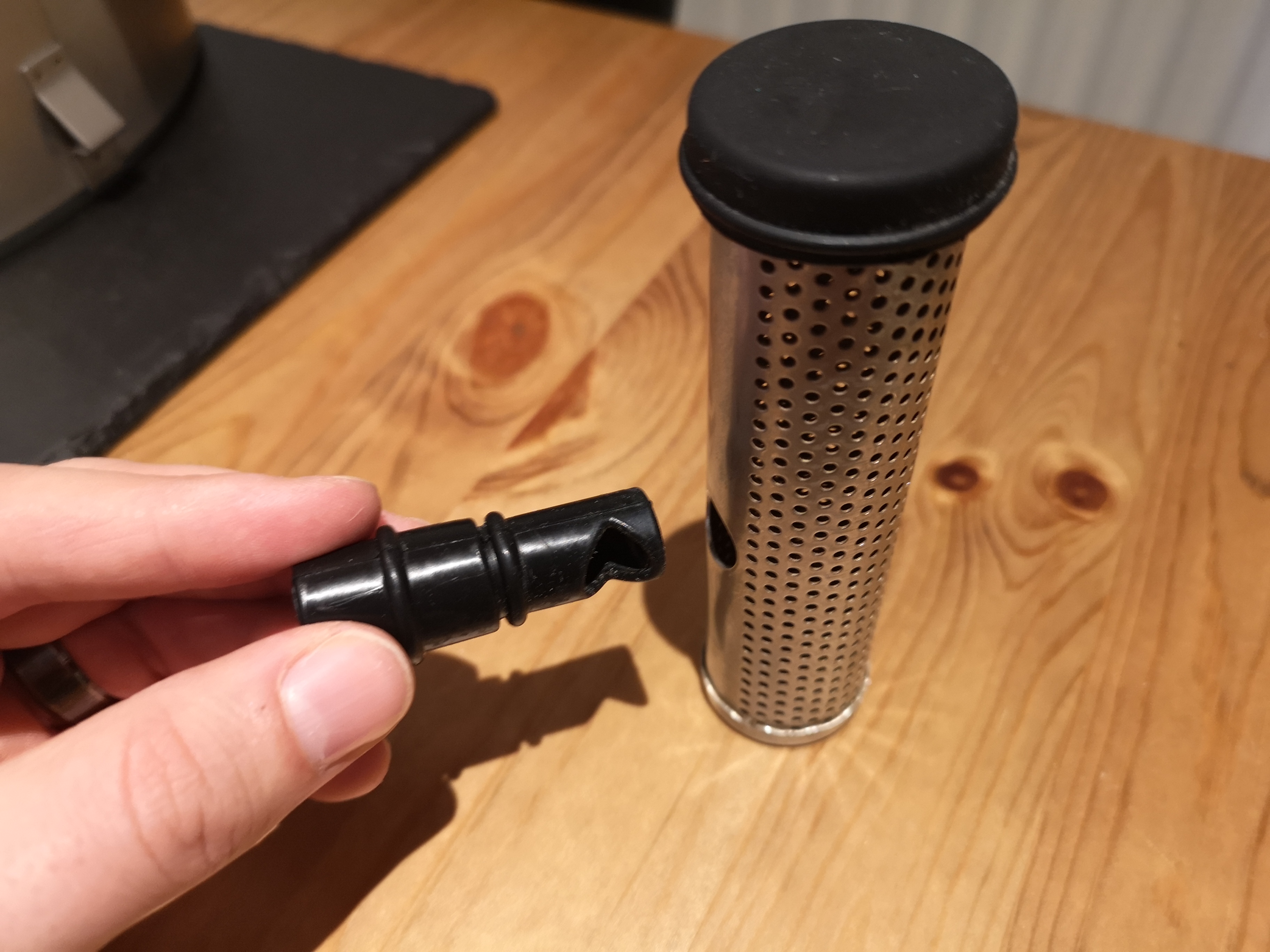
With the filter attached, you can now add the mash water. To work out how much water is required, you can use either the calculator in the GF Connect app, or the mash & sparge calculator on the GF website (under calculators).
Enter the batch size, grain weight and boil time and hit calculate. It'll tell you exactly how much water you'll need for the mash and sparge.
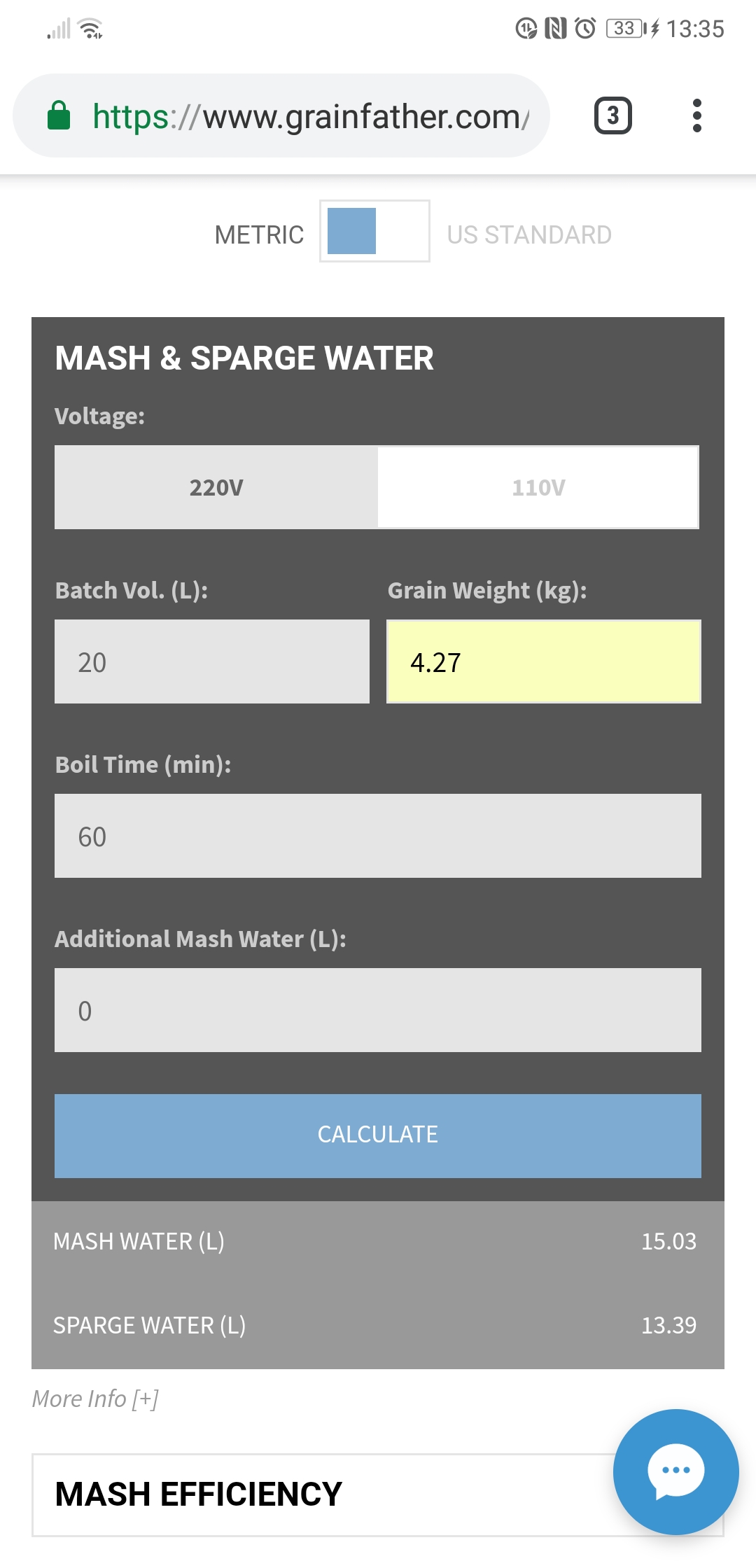
Don't worry about the sparge water for now, just add the mash water to the GF. Also don't be too concerned about being exact with the volume, I just round to the nearest half litre or so.
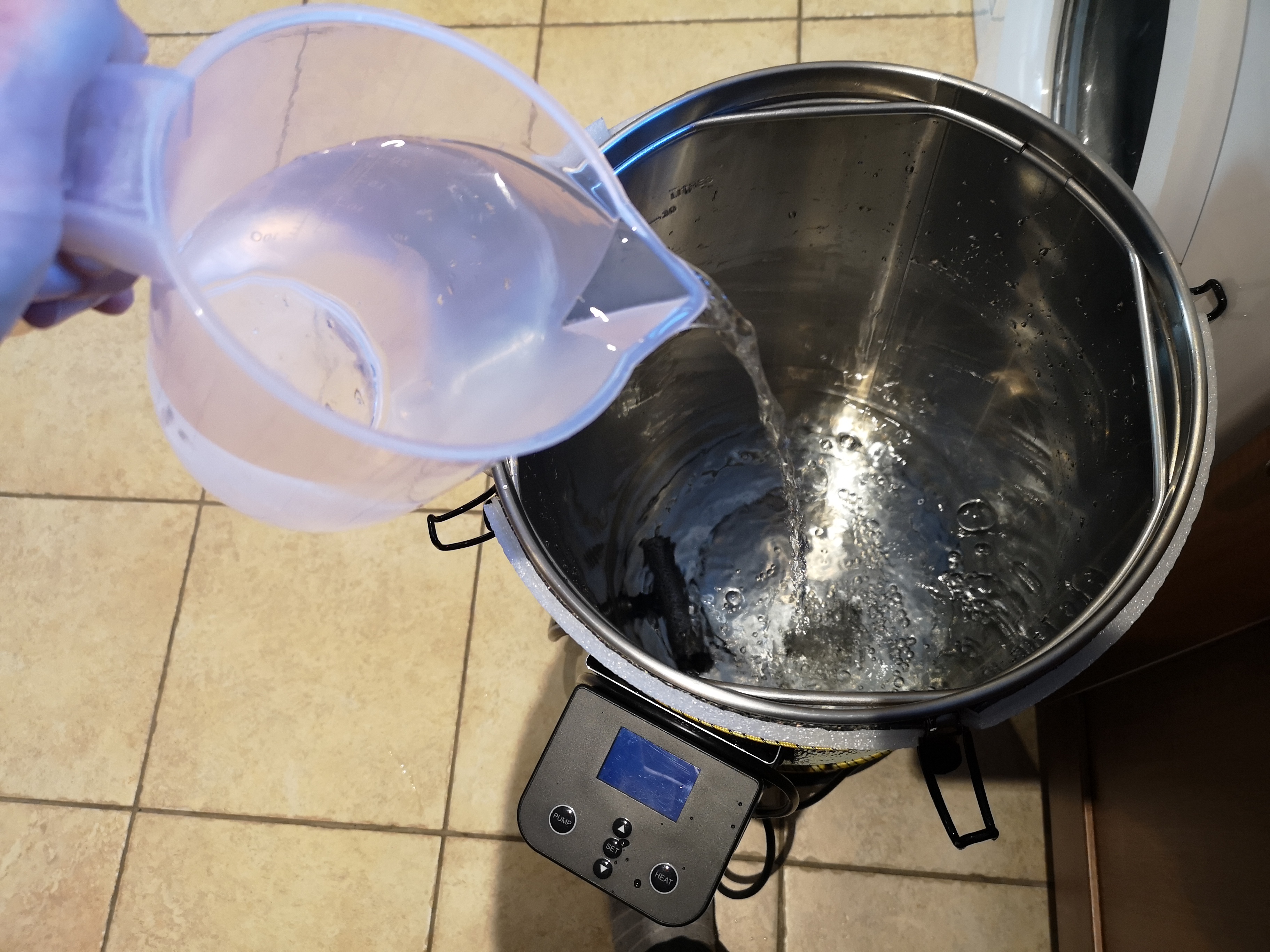
If you're planning any water treatment then now is the time to do so. If not then plug the GF in, set the mash temperature using the up/down arrows and hit “heat”.
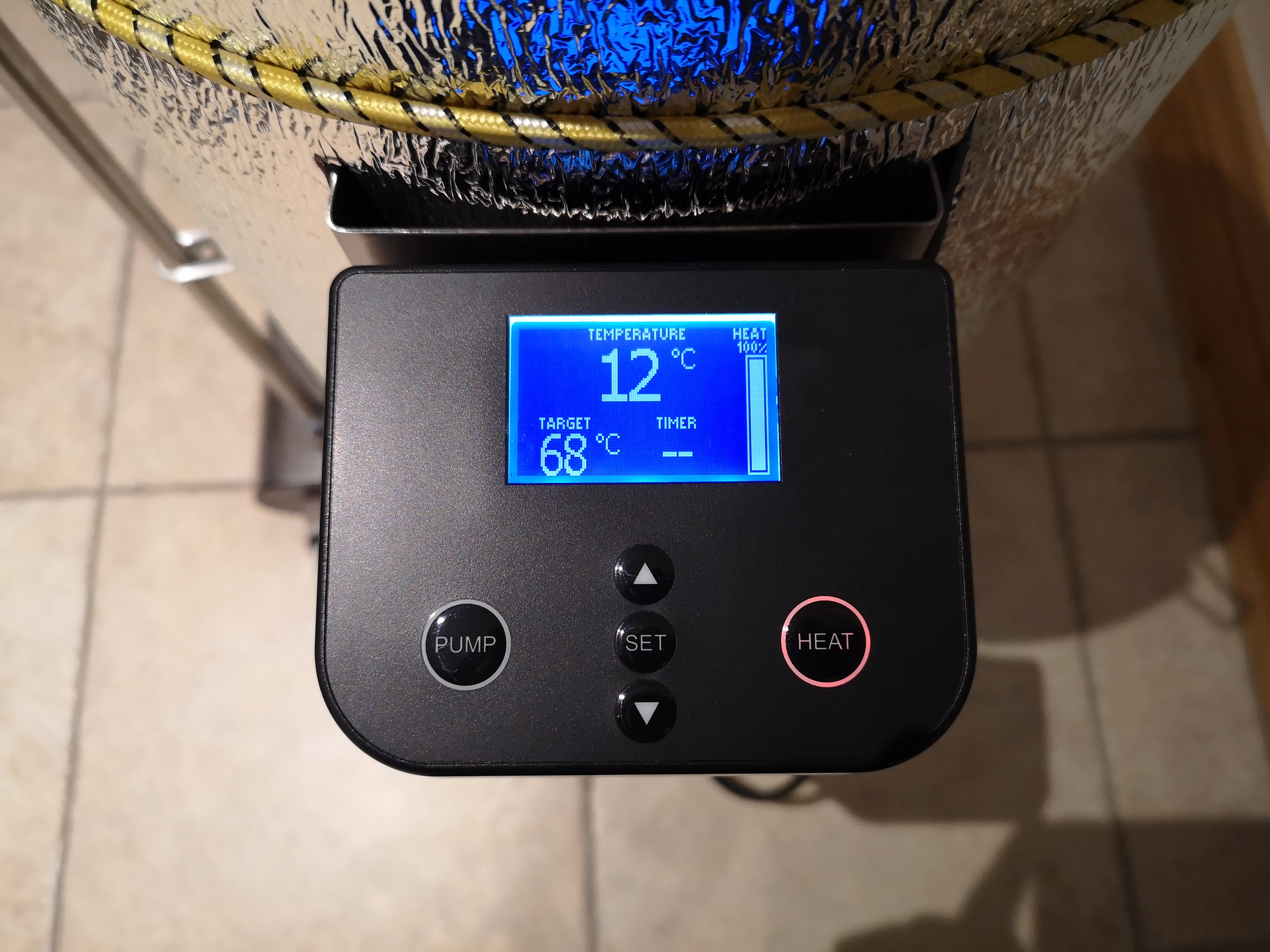
It'll take around 20-30 mins for the water to get up to temperature, so while you're waiting you can get your grain weighed out then assemble the malt pipe and plates. To do this, attach one of the rubber gaskets to the bottom perforated plate, that's the one which doesn't have the two little handles on it.
Then attach the lower pipe to the plate using the lock nut so you now have this…
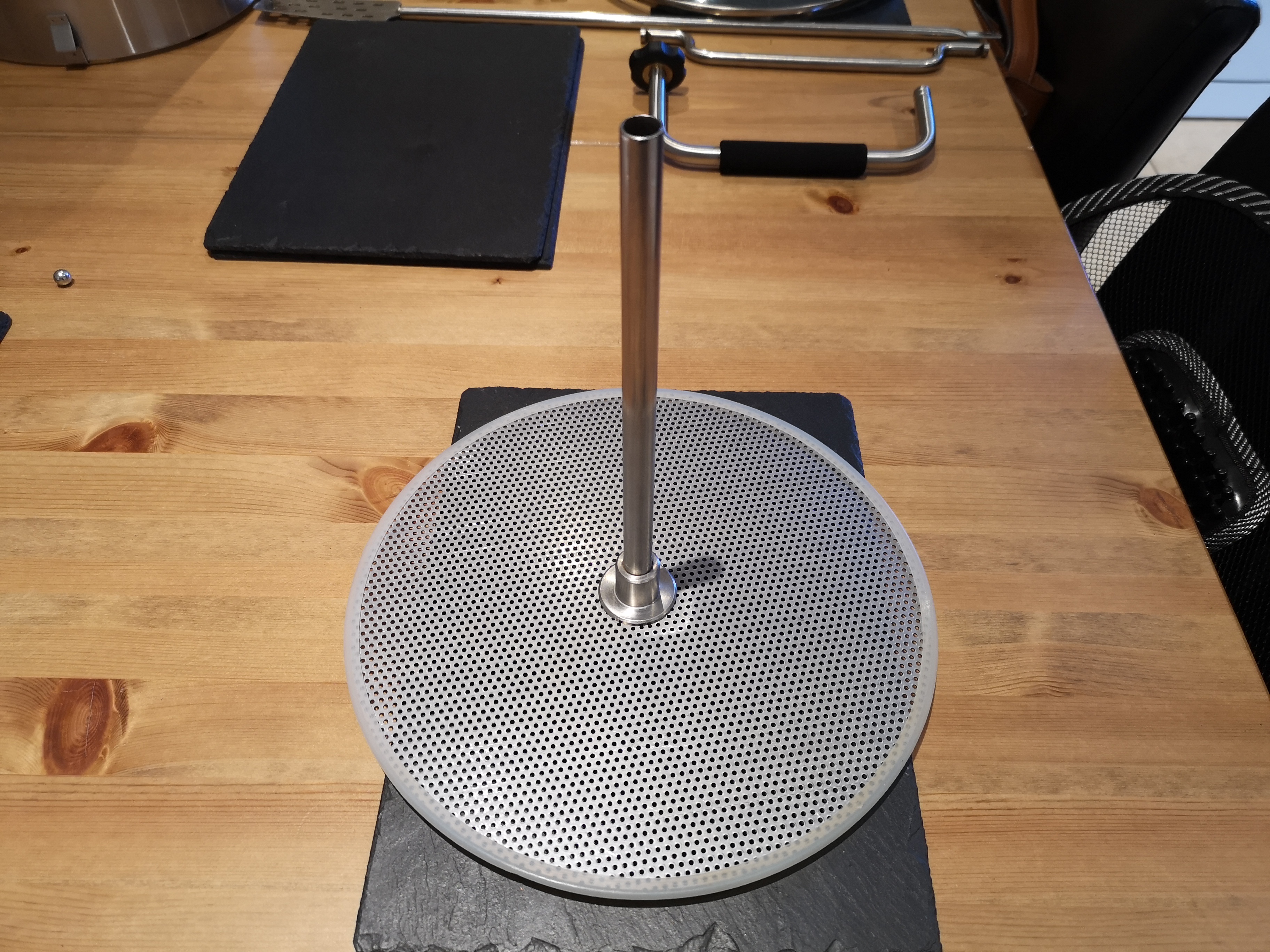
Now insert this into the grain basket. At first you might find this a bit tricky to do without pulling the gasket off, but if you wet the inside of the basket and/or the edges of the plate with water or a spray of starsan, and gently push the plate down at an angle, it should go in. Once it's in place, ensure the gasket is still seated properly.
Now attach the top pipe and grain stopper, pulling the pipe up to meet the cap on the stopper.
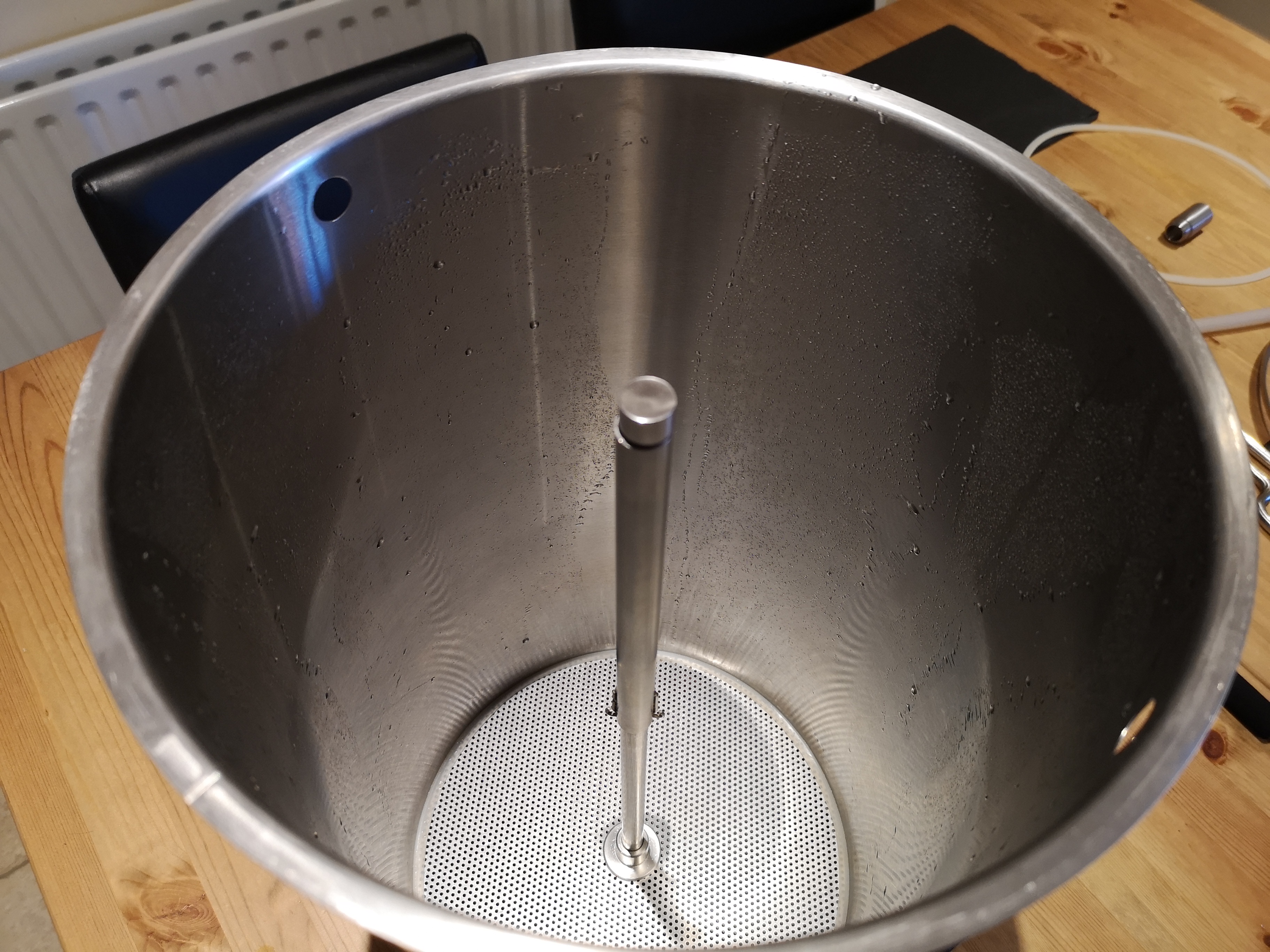
Next attach the second gasket to the top plate (the one with the handles) and set aside for now. You can now place the empty grain basket into the still heating GF, and await mash temperature being reached.
Once the water is up to temperature, it's time to add the grain. For the sake of efficiency, it's important to take this step slow and steady. Don't just dump the grain in, add it gently and gradually, stirring often. I use a 1L jug as a scoop and stir it well after every couple of jugfuls.
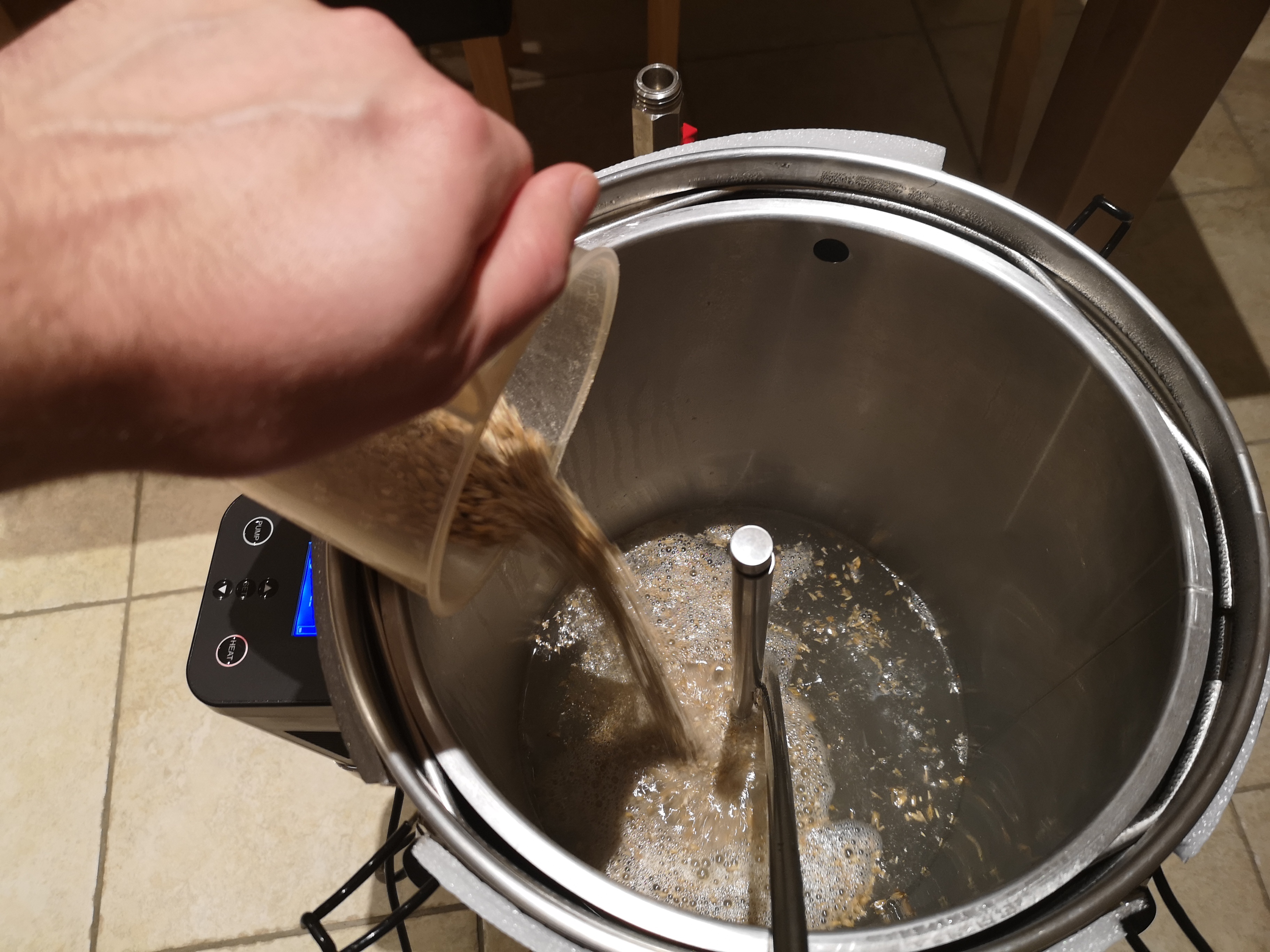
After all the grain has been added, stir for another few minutes to make sure the grain is well mixed and there are no dry spots or dough balls. Taking your time with doughing-in will really help your efficiency.
Next insert the top plate. This should go in a little easier than the bottom plate. The correct positioning of this is just below the water level, it doesn't need to be pushed right down onto the grain.
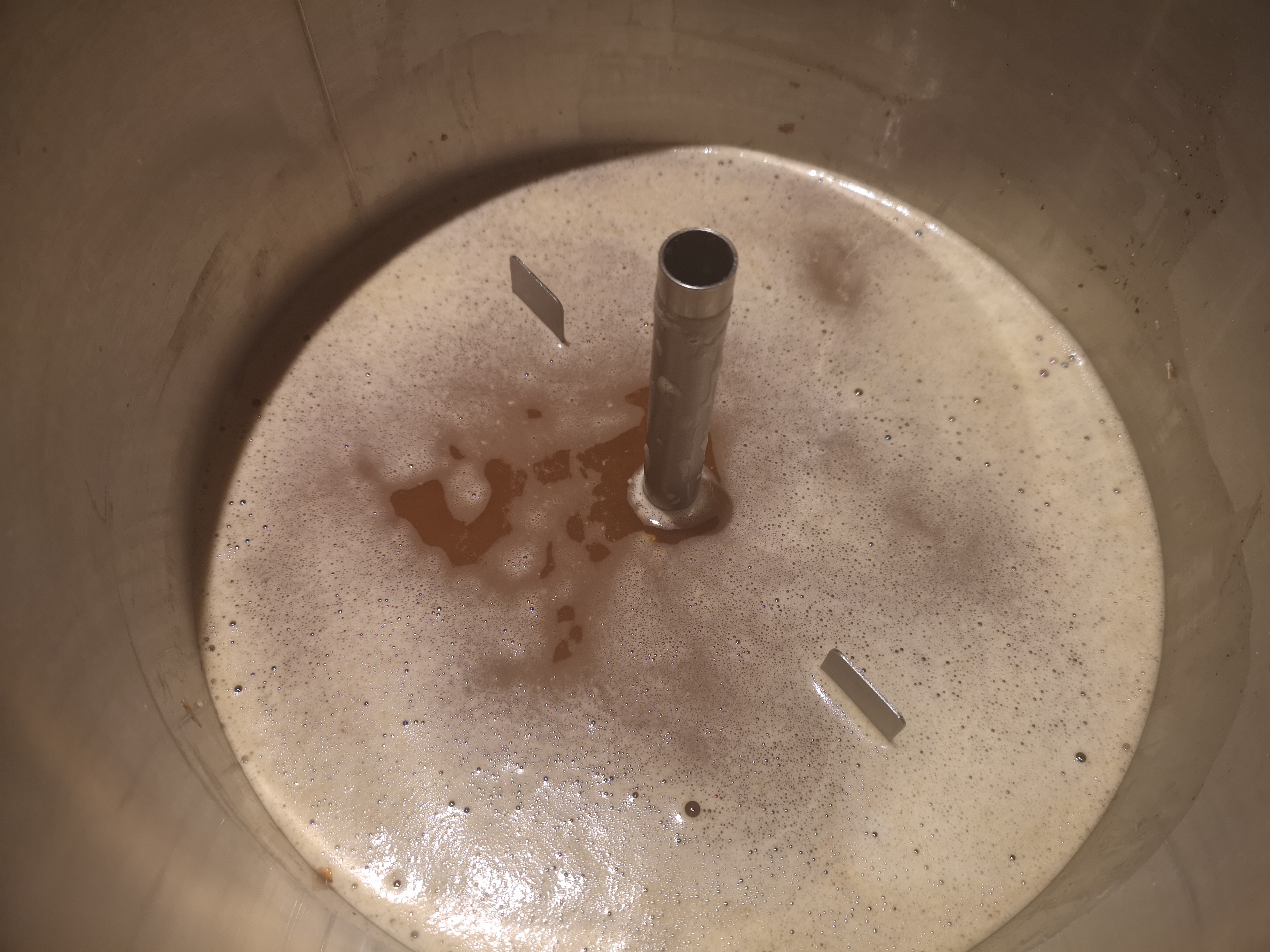
Next remove the grain stopper, place the overflow inlet onto the top pipe and push it down until the inlet slots into the hole in the top plate like so…
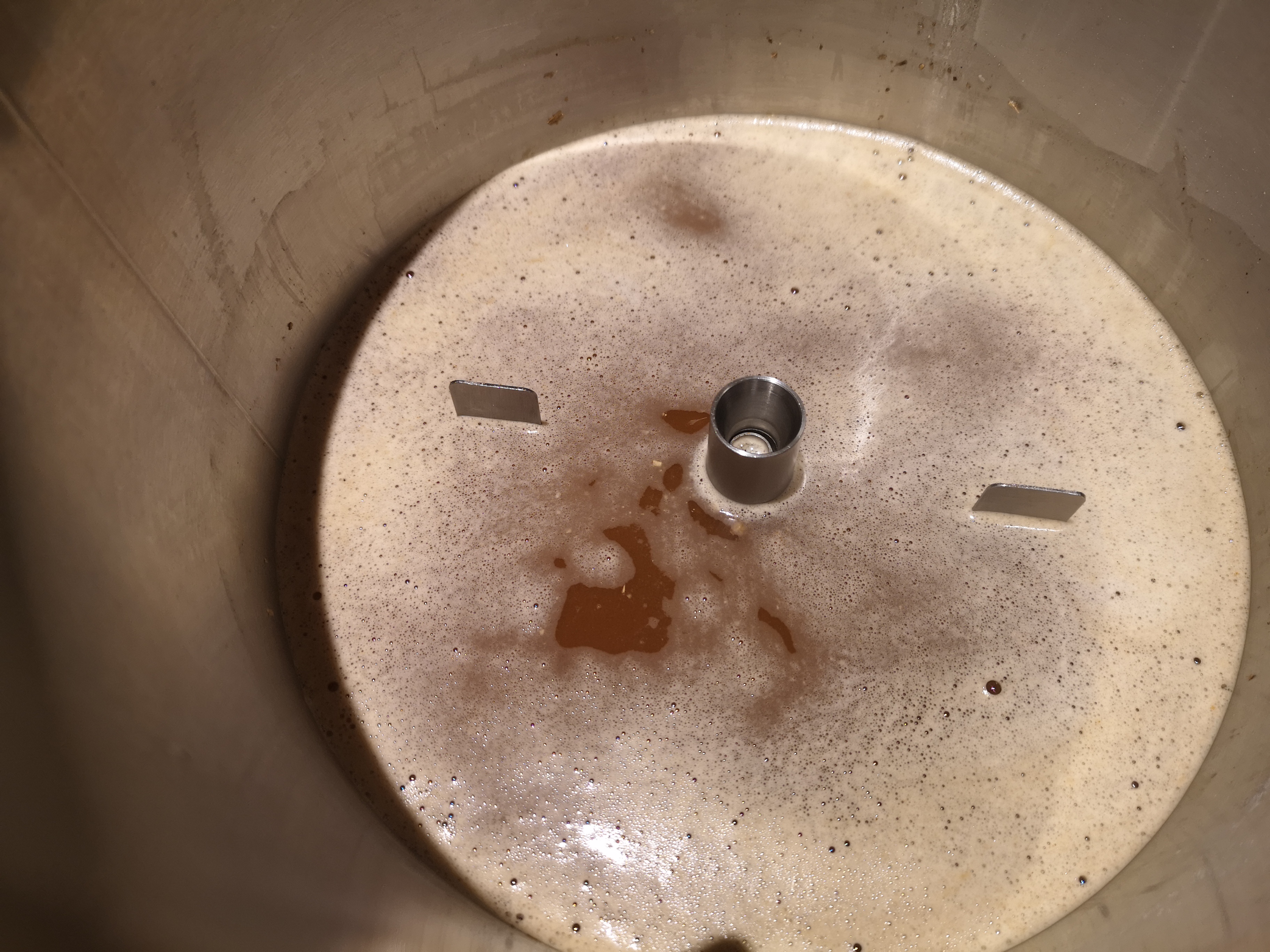
Next place the lid on the GF, attach the silicone hose to the recirculation arm, and with the hose through the hole in the lid, screw the arm onto the top of the ball valve. The hose should be sitting on the top plate but not kinked.
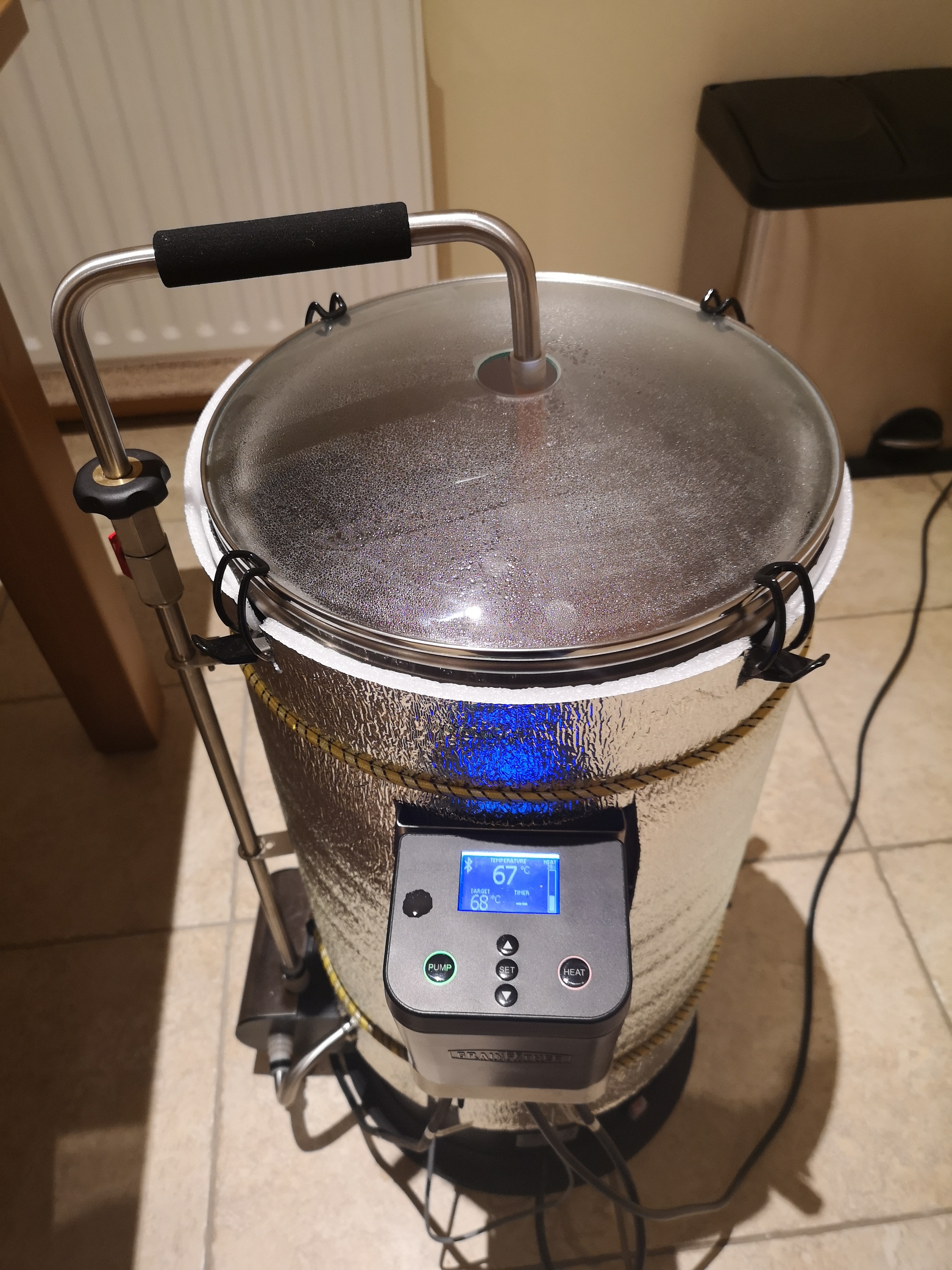
Now you're ready to start the mash recirculation, so with the ball valve in the open position, hit the “pump” button and start a timer with your mash time. The wort will start to flow onto the top plate…
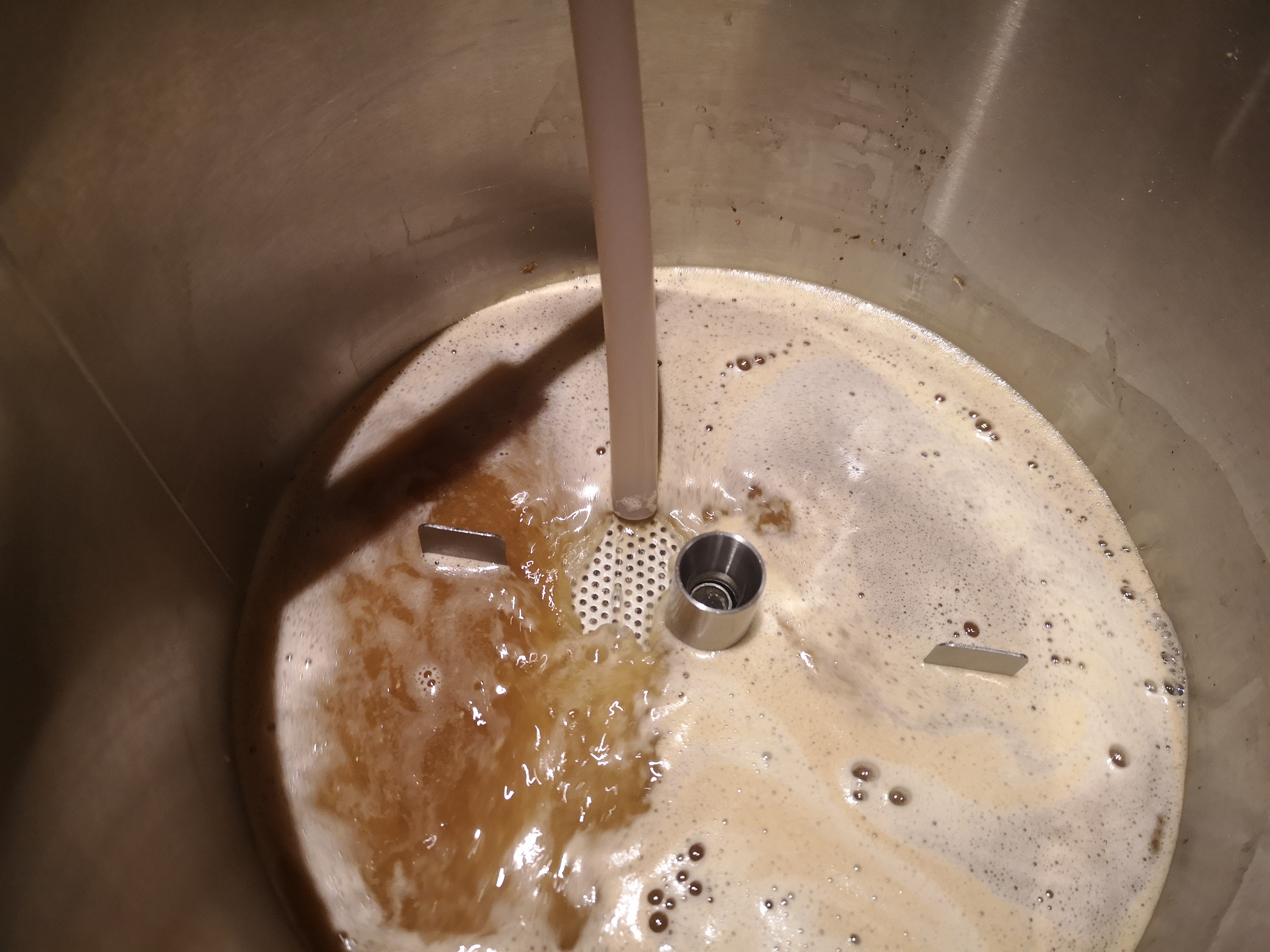
Now there's some disagreement on the recirculation rate here. Some say you should turn the flow rate down with the valve so that there is no wort going through the overflow. Others say you should just leave it on full and let it overflow. I have tried both and honestly don't think it makes a big difference to efficiency. I tend to compromise between the two, and turn the flow rate down a bit so there there is only a small amount going through the overflow as per the pic below. You might even find, depending on the grist and crush, that there is no overflow even with the valve fully open. The flow rate through the grain will probably change as the grain bed settles and the grains gelatinise, so you can open or close the valve to suit. You can play around with flow rates yourself in subsequent brews but don't worry about it too much for now.
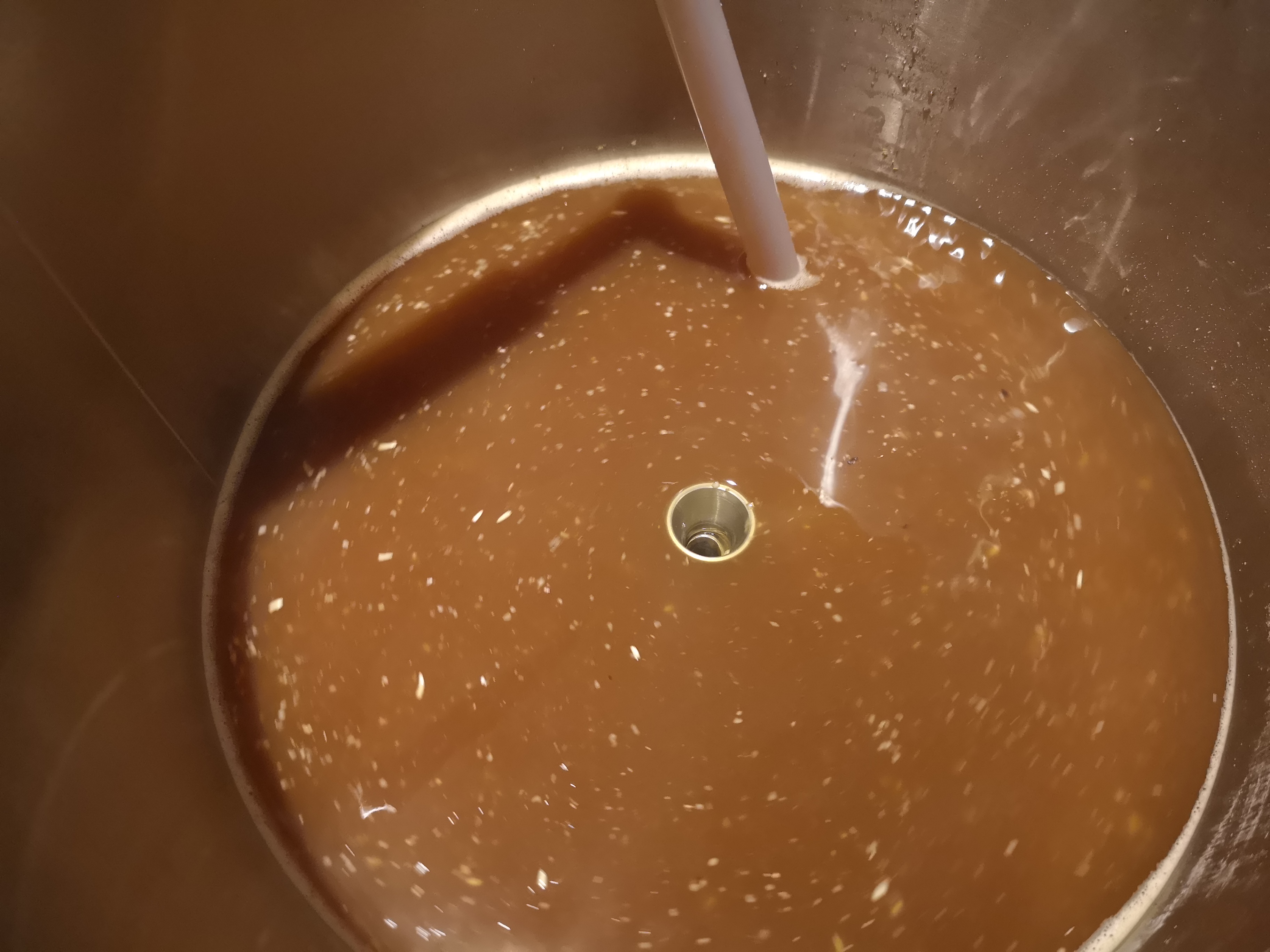
It's a good idea to stir the grain bed once or twice during the mash. To do this, stop the pump and let the wort drain out of the recirculation arm, remove the arm, the lid, the overflow inlet, and the top plate (these will be hot so gloves may be in order). Stir the grain thoroughly, making sure to get all the way to the bottom of the basket.
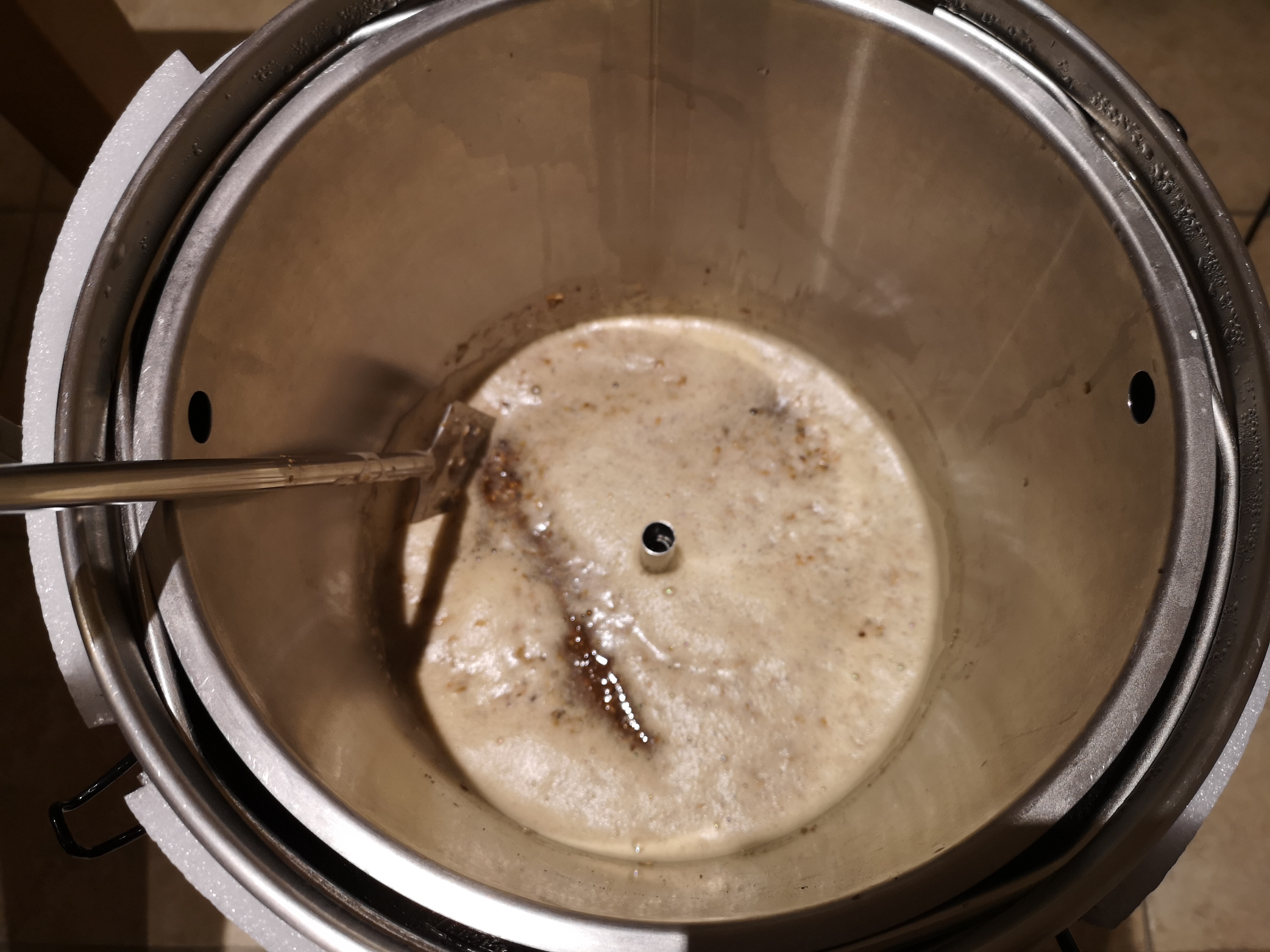
Replace everything then continue with the recirculation. While waiting for the mash to do its thing, you can collect sparge water as per the volume from the calculator. My sparge water heater takes about 25-30 mins to get up to sparge temperature, so I switch it on half an hour before the end of the mash. You want the sparge water to be at 75°c or thereabouts as your mash time is complete. I recommend doing a mash-out at the end of your mash, which simply means when the mash is done (after an hour usually) the temperature is raised to 75-77°c and rested for 10 mins.
During the mash is also a good time to weigh out your hop additions.
So now the mash (and mash-out) is complete, it's time to sparge. You may want to take a refractometer reading or iodine test at this point to check conversion.
Next switch off the pump and remove the recirculation arm and lid. Insert the grain basket handle and slowly lift the basket and set it onto the support ring like so…
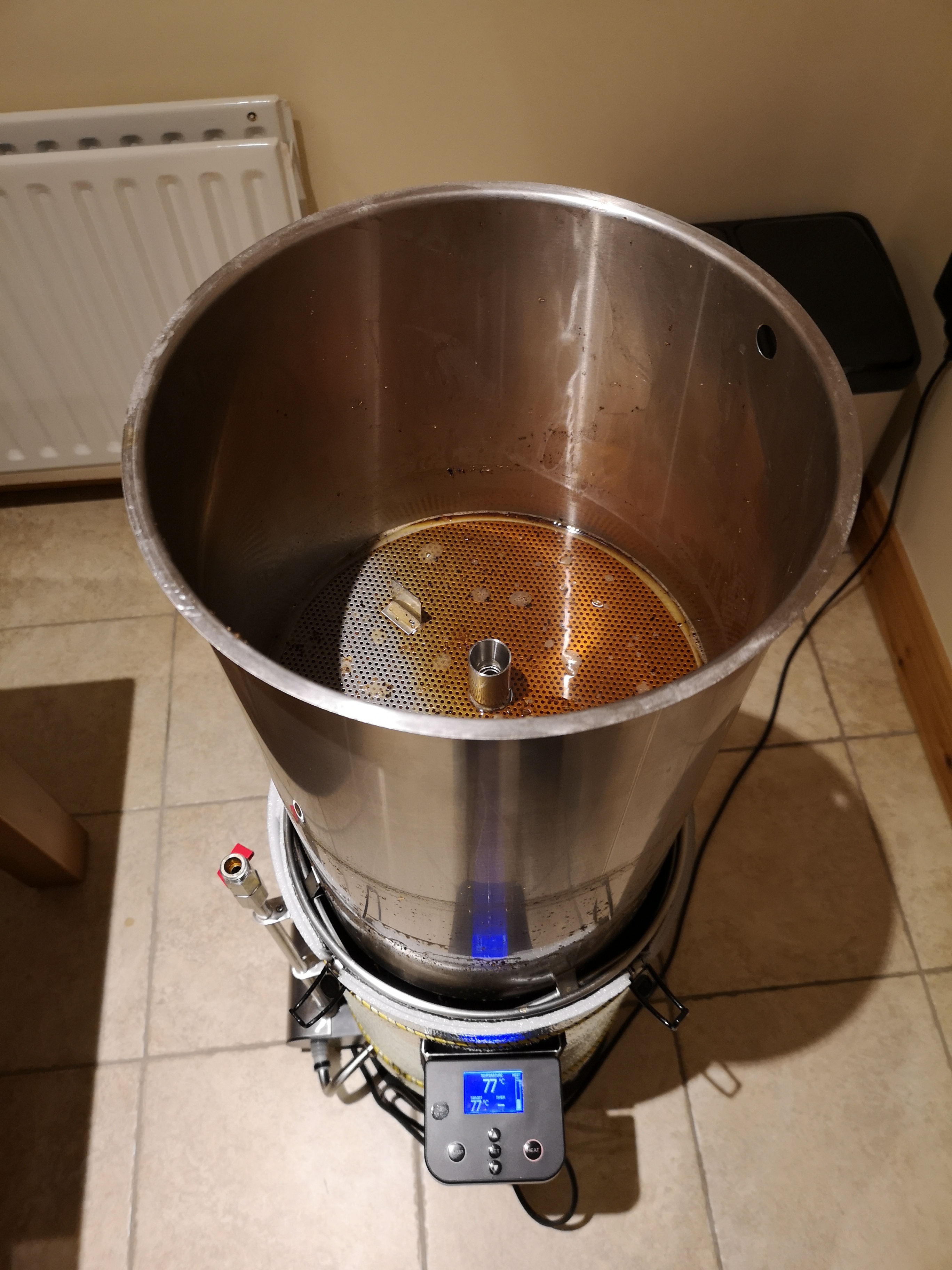
The wort will begin to drain from the basket, and as the level drops below the top plate, gently push the plate down until it's sitting on top of the grain. Push the pipe and overflow inlet down to slot into the top plate again.
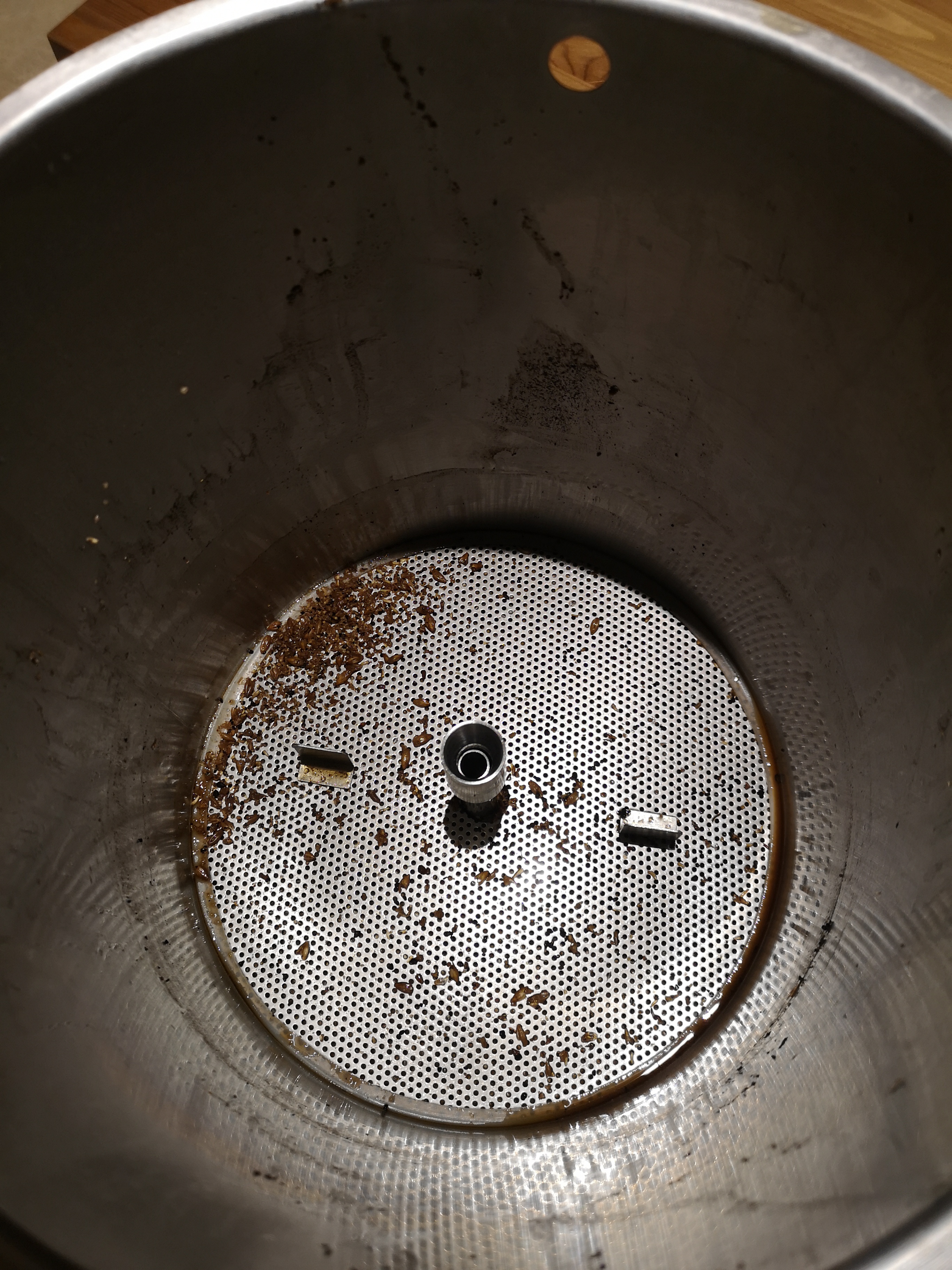
You can now crank the temperature up to 100° because it'll take some time to get there. Now begin to sparge. Much like the mash-in, take this step slow and steady. Take a jugful of your sparge water, which should be around 75°c, and pour it over the top plate.
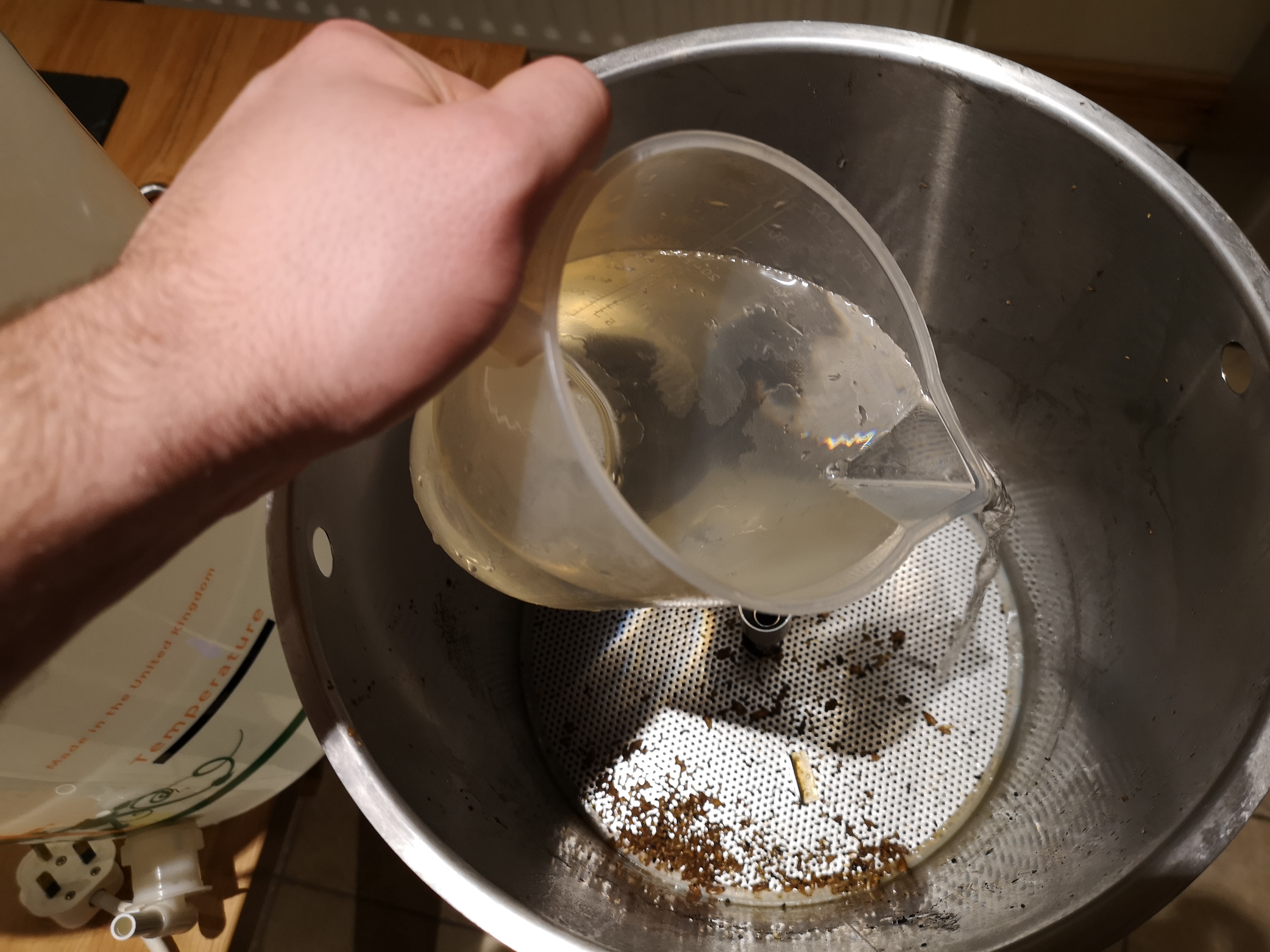
Some people like to keep the water level above the plate, but I think it's more important to sparge slowly, making sure to pour the water all over the grain. You can pour it over in a circular fashion, from outside to inside, or in straight lines, back and forward, left to right. Whatever way you do it try to cover the whole grain bed to rinse out as much residual sugars as possible. Keep doing this until you've used all of the sparge water.
Last edited: Jan 11, 2019Leave the basket sitting in place to drain until the wort gets up near boiling point, but be sure to remove it before it actually starts boiling. This is a surefire way of having a boil over. By the time the wort gets to mid 90s the basket should be well drained, so set it aside for now and turn your attention back to the GF.
Be sure to keep the lid off from now until the end of the boil. As the wort comes to the boil it'll begin to foam up. Stir this back in to prevent boil overs, it'll settle down after a few minutes.
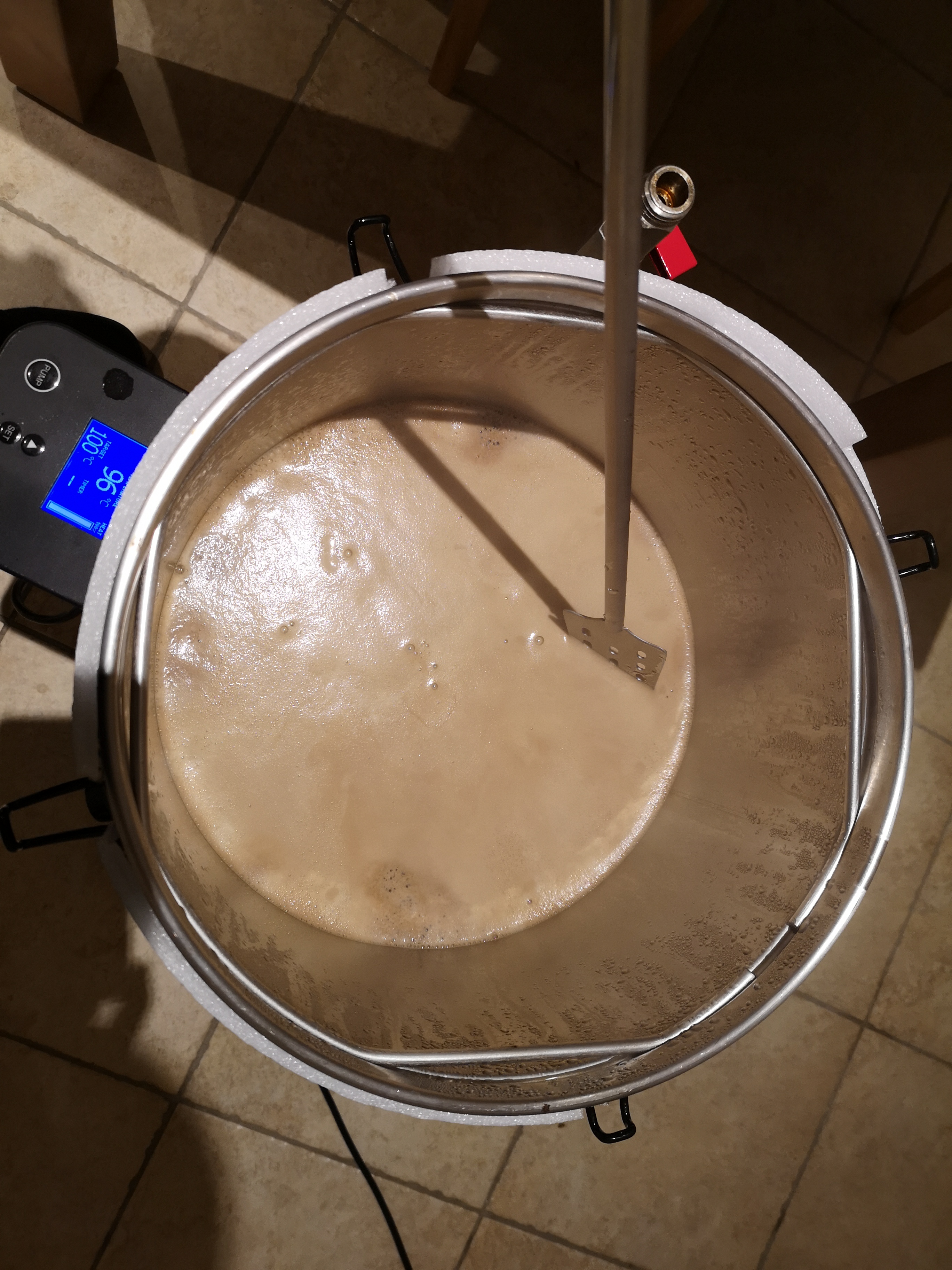
As soon as you have a nice rolling boil, start a timer with your boil time and add the hops as per your recipe.
Every 15 mins or so during the boil, take your paddle and gently scrape the bottom of the boiler to prevent proteins scorching on the bottom.
Now is a good time to dispose of the used grain and clean the grain basket, plates, pipe work and overflow inlet. I do this outside because it can be a bit messy. Dismantle all the various parts and rinse under a tap. Use a non-scratch scouring sponge to remove any stubborn residue.
Once these bits are clean and dry, they can be put aside for storage, you're done with them for today.
Towards the end of the boil you want to start thinking about sanitising the FV. I do this by giving it a rinse out with boiling water from the kettle, then a good spray with starsan. When that's done I put the lid on and set it aside till I need it.
If you're planning on rehydrating dry yeast, now is also a good time to boil some water so that it has time to cool before using it.
About 10 mins before the end of the boil you can sanitise the wort chiller. To do this, set it on a chair beside the GF, connect the wort-in hose to the recirculation pipe and dangle the wort-out hose into the top of the GF. Don't worry about connecting the water in just yet.
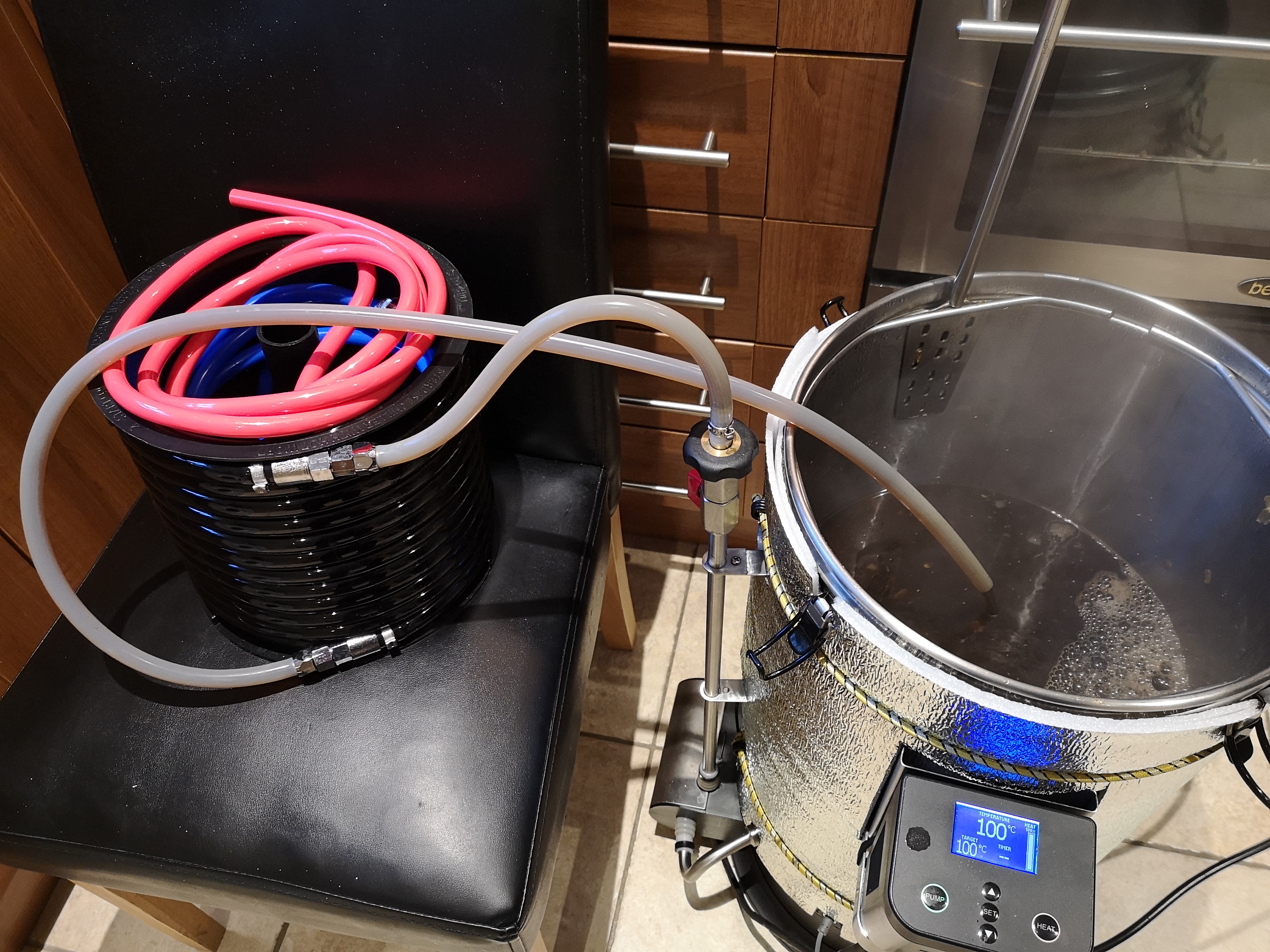
Next, with the ball valve open, hit the pump button and the hot wort will begin to flow through the chiller, sanitising it. Stop the boil timer while this is happening, because the temperature will drop a few degrees. Circulate the wort through the chiller for about 5 mins or so.
When that's done, stop the pump and let the wort drain out of the chiller hose. When the temperature gets back up to boiling restart the boil timer. You can now connect the water-in hose (the blue one) to your water supply but don't turn it on yet. Position the water-out hose (the red one) so that it can drain safely. The wort chiller is now sanitised and ready to use.
Whenever your boil time is complete, switch off the heat then grab your paddle and give the wort a good stir for a couple of minutes to get a decent whirlpool going. Place the lid on the GF and let it settle for 5 mins. Doing this will help the wort flow a little easier without clogging the filter up during the next step.
While waiting, now is a good time to rehydrate your dry yeast if you're doing so.
At this point, I use another common little trick which is to remove the ball and spring from the check valve. The reason for this is that I've found the spring can get clogged up with hop material during the transfer, but for your first brew you may well want to skip this step because I know many people have no issue with this.
The check valve is the bit attached directly on top of the ball valve. Inside is a ball and spring which is a safety feature to prevent you from pumping hot wort all over your open-toed sandals, because the check valve will only open if the recirc arm or chiller is attached.
That means if you remove the ball and spring ensure that the ball valve is off and/or the recirc arm/chiller is attached before you switch on the pump!
So if you want to remove it, this is how. With the pump switched off (duh), grab the ball valve with one hand and with the other hand twist the check valve anticlockwise. It shouldn't be so tight that you can't loosen it by hand. Remove it carefully so that the spring doesn't fly away. Take out the ball and spring, put them somewhere safe, and replace the now empty check valve. Hand tight is good enough.
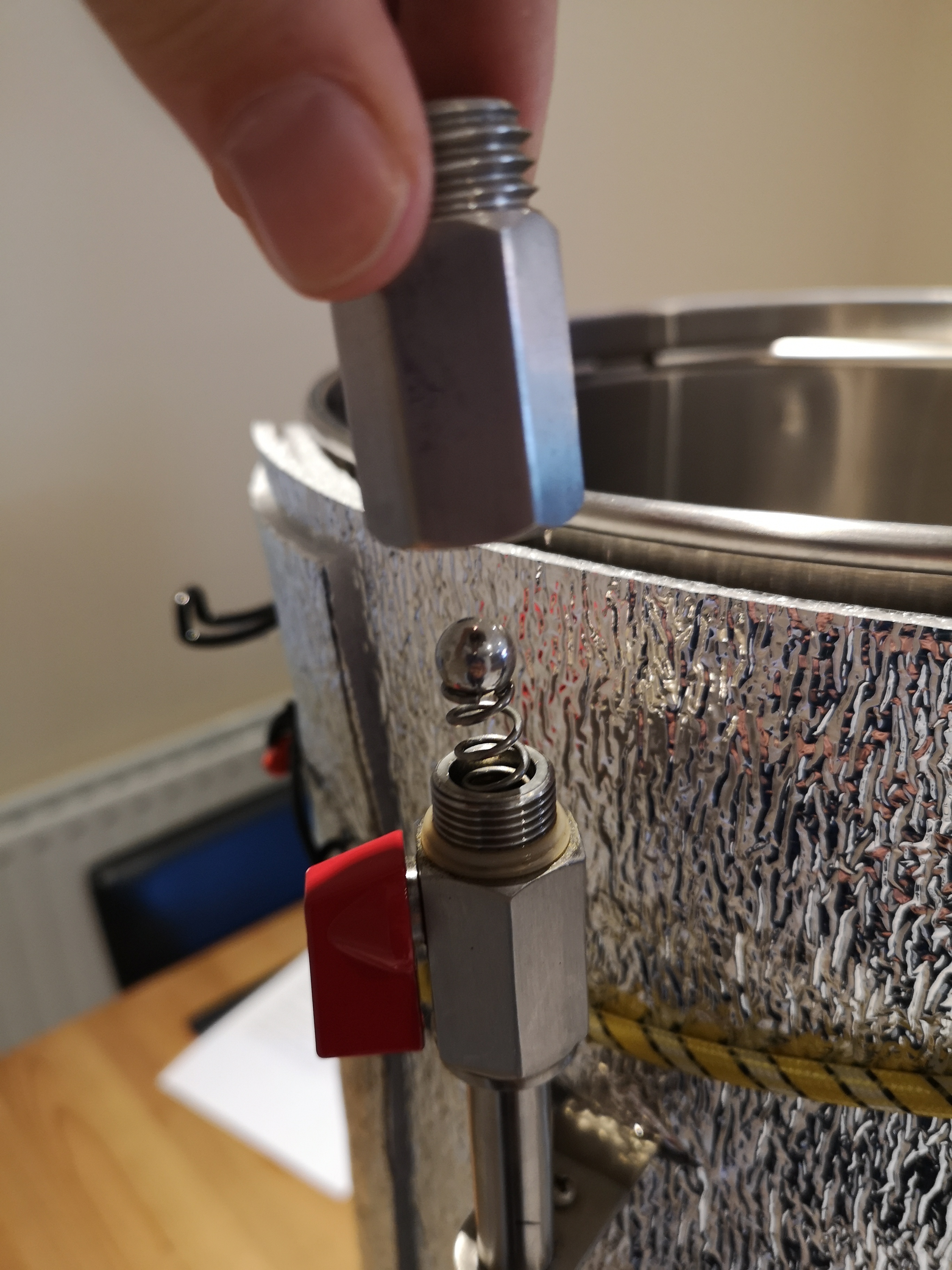
Now you're ready to begin chilling and transferring to the FV. Begin by turning on the water, and if you have a spare FV handy, you can collect the hot water coming out the other side for cleaning later. Then with the wort-out hose in the top of the FV switch on the pump. Grab your thermometer and check the temperature of the wort flowing out of the hose. Adjust the flow rate with the ball valve until it's as close as possible to your pitching temperature. I actually like to aim for a degree or 2 lower.
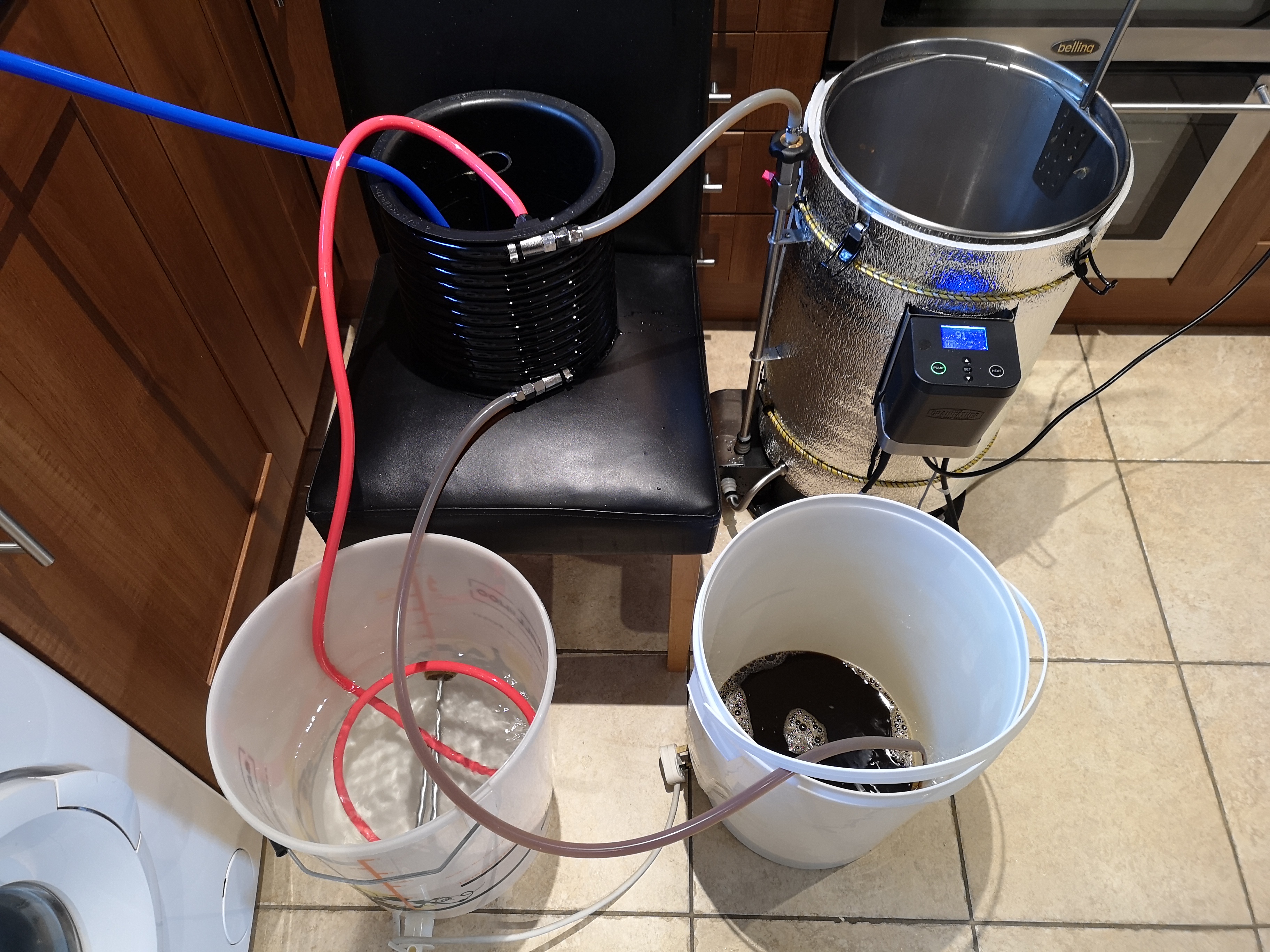
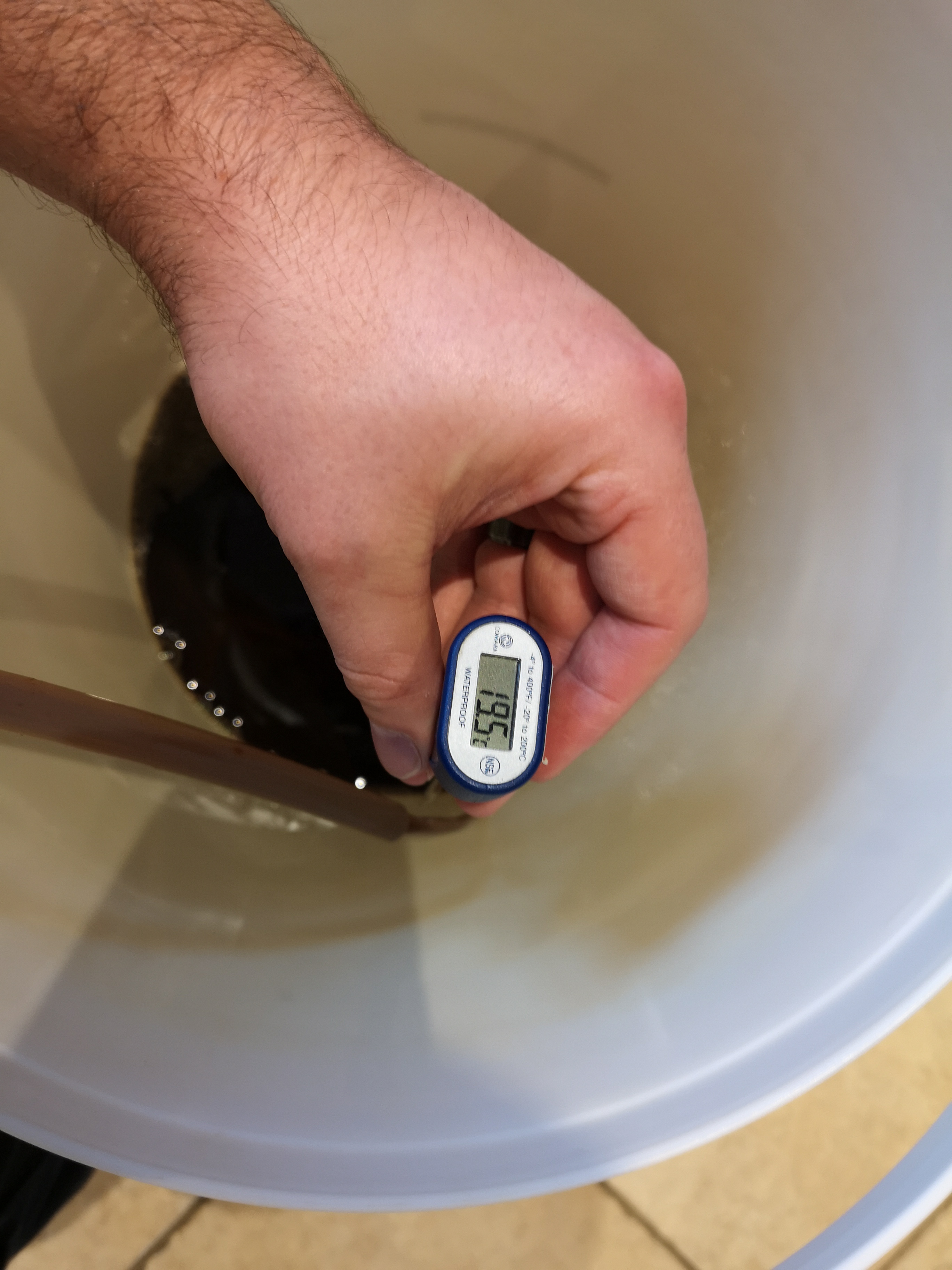
During the transfer you may see the flow rate slow down as the filter gets caked with bits of hop. That's no big deal and you can adjust the ball valve to compensate. However if the flow gets very slow, even with the valve fully open, you can use your paddle to carefully scrape the filter. Be careful not to knock the filter off though. If this doesn't help, you might need to remove the ball and spring from the check valve as discussed above.
At the end of the transfer, I like to tip the GF towards the filter to get the last of the wort pumped out but be sure to switch off the pump before it runs dry, this isn't good for it.
Now the transfer is complete, check the temperature of the wort with a sanitised thermometer and if it's good, pitch your yeast, aerate and take an OG reading.
Now you can clean the GF. Start by tipping out the hop debris/trub into your bin/compost heap/prefered disposal method. Then pour a little warm water into the GF and use a sponge to clean off the worst of the residue. Tip out the water and repeat if necessary.
Then add 15L or so of water (the waste water from the chiller is ideal for this) to the GF, set the temperature to 60° and when it gets to temperature add 2 tablespoons of the GF cleaner. Attach the chiller and start the pump to recirculate the cleaner through it. There will probably be some wort in the chiller which will come out initially so dump this down the drain before putting the out tube into the GF.
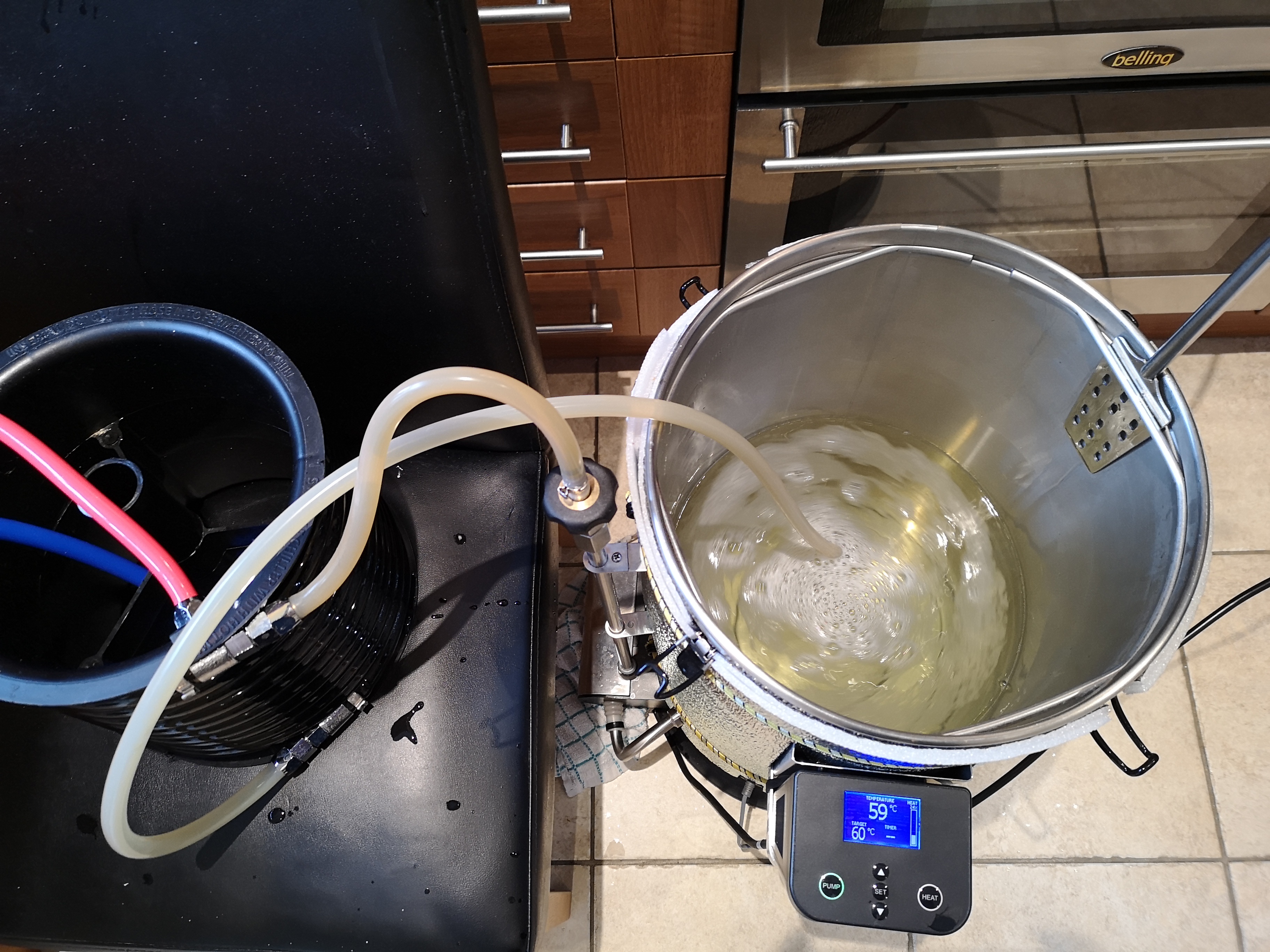
Leave for 15 mins then swap the chiller for the recirc arm and leave for another 15 mins. Next you can discard the cleaning fluid by pumping or tipping it out. At this point I add some fresh water to rinse, again circulating through the chiller and the recirc arm for a couple of minutes. Again dump this water out, dry the inside with a clean cloth or tea towel, place all the various bits and pieces back inside and you're done!
Congratulations, you've just completed your first Grainfather brew, time to start preparing for the next one